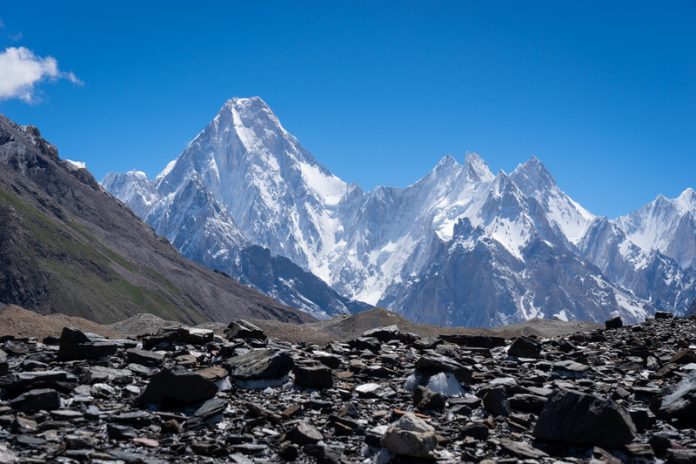It is well known that the current rate of warming in response to increasing ‘greenhouse-gas’ concentrations (e.g. CO2) is amplified at high latitudes and with increasing elevation in mountains. This rapid warming has important implications for ecosystems, human activities, and alpine biota. Linked to this warming are a glacial retreat and upward shift of tree-lines, creating further threats to alpine biodiversity.
Alpine plants grow above the tree-line in mountains globally. They occur in areas with low temperatures, very low night-time temperatures, frost, short growing season, and high winds or extended snow-lie. Many grow very slowly; some living for 100+ years. They inhabit such extreme habitats because of their physiological tolerances and inherent requirements for cold and/or intolerance to competition from taller, rapidly growing plants of lower elevations. Some alpines, but not all, can be grown in lowland gardens in the absence of competition. Because of their ecological specialisation, alpines are potentially sensitive to climate change.
In the absence of long-term permanent recording plots, studying how alpines are responding to climate change requires (1) reliable botanical records from the past 100 years, (2) a repeat survey today using identical methods as the original survey, and (3) a critical comparison of past and present species occurrences.
Investigations in the European Alps show increased species richness on high (>3000 m) summits during the last 100–150 years. Kari Klanderud showed that richness between 1600– 1800 m elevation had increased since 1930 by 8–14 species and between 1800–2000 m by 5–8 species, but that richness above 2000 m showed little change in the Jotunheimen mountains (central Norway). Grasses and dwarf-shrubs (e.g. mountain heath, crowberry; figure 1) have expanded their elevational limits by 200–300 m since 1930. No high-alpine summit species such as the glacier buttercup or tufted saxifrage (figure 1) have gone extinct.
Many such resampling studies have now been done in Europe, the Caucasus and Ural Mountains, parts of East Africa, and the Americas. John-Arvid Grytnes has synthesised the results of 114 resurveys of European mountains to test competing hypotheses about the causes of species shifts – atmospheric nitrogen-deposition, precipitation, temperature, land-use changes, etc. Seventy per cent of species showing detectable changes in their upper limits has moved upwards. The same species tended to move up on different mountains. There were large differences between mountains in the proportion of species shifting upwards. This proportion is not related statistically to temperature changes. Species associated with late snow-lie have become commoner on summits. These findings suggest that plants are partly responding to climate through elevational changes in snow lie resulting from a complex of temperature and precipitation changes. Such changes allow more competitive plants to expand upwards. This synthesis suggests that recent climate change is affecting alpine plants but that the link is more complex than a simple species response to increasing temperatures.
These field-based results contrast with predictions about impacts of future climate change on alpines from species–climate ‘niche’ models. The models suggest drastic changes with many species going extinct by the next century, but, caution is needed because their coarse spatial scale (e.g. 50´50 km) fails to capture the fine-scale topographic and microclimatic variations so characteristic of alpine landscapes.
One important result of the resurveys is that there is little evidence for local extinctions, especially at the highest elevations where climate warming would be expected to have the greatest impact. Daniel Scherrer and Christian Körner (Basel) have shown that there is great variation in soil and surface temperatures due to numerous microhabitats within an alpine landscape created by high topographical variation (ridges, hollows, streams, etc.). Local-scale variations (7.2K for mean growing-season soil temperature,) exceed IPCC warming predictions for the next 100 years. A 2K regional regional scale warming leads to a 3% loss of the currently coldest microhabitats in their study areas. Such cold microhabitats will not be lost altogether. Warm microhabitats will become more frequent and new warmer microhabitats may develop. The observed increases in plant richness seen on European mountains are likely a response to increased microhabitat diversity. Rugged alpine terrain is a ‘safer’ place to live under conditions of rapid climate change than flat terrain that offers no nearby ‘escapes’ from new thermal regimes.
Are entire alpine ecosystems changing in response to recent environmental changes? Studies of algae and animals show that major biological changes have occurred in alpine lakes during the last 100 years. These changes may result from increased atmospheric nitrogen deposition, acid-rain, or climate change, or interactions between these drivers. However, the nitrogen and acid-rain hypotheses are unlikely to be driving changes in remote lakes in the Andes studied by Neal Michelutti, Andrew Labaj, and colleagues (Kingston). Such studies demonstrate the recent development of new ecological states in remote alpine lakes, just as there have been major shifts in many arctic and temperate alpine lakes and in arctic and alpine floras.
Although alpine habitats and their biota are often thought of as ‘pristine’, they are being increasingly impacted, to varying extents, by climate change, nitrogen-deposition, tourism, hydroelectricity development, land-use changes, introduced species, and over-exploitation leading to erosion and landscape degradation.
Mountains cover 24% of the Earth’s land surface and 26% of the world’s population lives in or by mountains. They provide water for over half of mankind directly or indirectly as mountains hold about 66% of the world’s freshwater as snow or ice. Stephen Venables recently wrote, “Mountains are the ultimate litmus test of what is happening on our planet.” Alpine plants and their recent changes are an important part of this ‘litmus test’. They warrant greater study as they have much to tell us about biodiversity responses to future changes.
H John B Birks
Professor Emeritus
Ecological and Environmental Change Research Group (EECRG)
Department of Biology
University of Bergen
Norway & Environmental Change Research Centre (ECRC)
University College London, UK
Tel: +47 5558 3350
john.birks@uib.no











